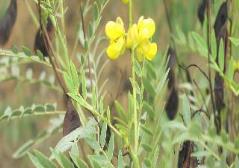
Senna angustifolia / الحلول
COMMON NAME
Arabian Senna, Senna, Indian Senna, Tinnvelly Senna
LOCAL NAME
Senna, Sanna Makkah, Sénemúkki, Holoul
Background
- Senna is an erect branched shrub of the legume family (Fabaceae)
- Distributed throughout the tropical regions of the world
- Widespread in UAE, found in valleys, lower slopes of mountains, and roadsides, along the sand and gravel.
Part(s) Used
Leaves & Pods, seeds and roots
Traditional and Medicinal Uses
Many Senna species are among the recognized effective traditional herbal medicines in different regions of the world. Senna preparations has been used as/for:
|
Cathartic |
Expectorant |
Gastritis |
|
Hemorrhoids |
Headache |
Weight loss |
How Much Do We Know?
- Senna is a common ingredient in many commercially available laxatives
- It is approved by the FDA as an OTC remedy for constipation for adults and children over two years.
- Senna is proven to be beneficial for short-term and chronic constipation
- In U.A.E, the powdered leaves or decoction of leaves and fruits, mixed with sugar and lemon or with aromatic herbs like anise, ginger to treat constipation.
What Do We Know About Safety?
- Senna is likely safe when used in the recommended doses
- Senna is possibly unsafe in chronic use and/or higher doses
Using Senna by
Mouth
- The maximum adult intake of Senna should not exceed equivalence of 34.4 mg sennosides twice daily
- The maximum children (6-11 years) intake of Senna should not exceed equivalence of 17.2 mg sennosides twice daily
- The maximum children (2-5 years) intake of Senna should not exceed equivalence of 8.6 mg sennosides twice daily
Special Precautions & Warnings
Pregnancy, Breast-feeding, Children
Senna is likely safe when used appropriately in the recommended doses
Keep in Mind
- Do not hesitate to speak with your health care provider before starting to use any supplements.
- Discuss potential benefits and risks, especially if you are suffering from any health problems.
